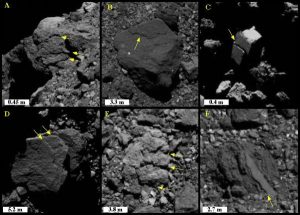Media
Transcript

CREDIT: NASA/Goddard/University of Arizona
Today we have new science on that giant rock pile in the sky we love to hate. Planetary Science Institute (PSI) Research Scientist Jamie Molaro and collaborators from all across the United States have just put out a paper describing how the heating and cooling cycles on Bennu may be responsible for its rock flinging habits. Now, I could try and explain this paper to you, but I decided it would be a lot more interesting to have Jamie explain things in her own words, and she’ll be joining us as a guest in just a few minutes.
For now, though, let’s take a look at what’s happening in the rest of the solar system.
Today’s top, click-bait style headline comes to us from NASA’s Jet Propulsion Laboratory (JPL). They would like you to know that Saturn’s moon Titan is moving away from Saturn one hundred times faster than previously thought. Based on the questions we’re already getting on this story, this news has a lot of people worried about the fate of Titan. Well, folks, a hundred times a very small rate is still a pretty small rate, and we’d like you to know that while Titan is on the move, its eleven centimeters per year migration isn’t going to affect its fate any time soon. Titan is just going to keep on orbiting Saturn for billions of years to come.

Moon migration is nothing new. Our own moon is migrating away at a rate of 3.8 centimeters per year. At the most simplistic level, this is driven by the conservation of angular momentum and tidal forces. Since moons and planets aren’t perfect spheres, gravity pulls on the lumps and bumps on every world and tries to slow to lock their rotation, so that these worlds eventually end up with the same face showing to whatever they are orbiting, just like the same face of the moon always faces us. This is the first order of what is happening, but things get more complicated when we look at the details, and it’s those details that get us to the accelerated rate of the retreat we now see for Titan.
As I said, we knew Titan was migrating; we just had misunderstood how fast. Prior estimates were calculated, but this new research is based on analysis of data from Cassini. Specifically, scientists analyzed radio signals Cassini sent toward Earth during ten flybys of Titan that took place from 2006 to 2016. The interactions between the radio waves and Titan, when used in concert with optical images of Titan against star fields, gave the team two different approaches to measuring Titan’s position and motion.
This new result confirms a 2016 paper by CalTech’s Jim Fuller that revisited how inner and outer moons can migrate and determined that outer moons can migrate outward faster than more simplistic calculations predicted.
With this new analysis of Titan’s observed motions, it’s possible to work backward to sort out the evolution of the Saturnian system. As we’ve brought up before, the exact age and history of Saturn’s rings is a matter of much debate, and it remains unclear how old or young or long-lasting the rings may be. This work is published in Nature Astronomy in a paper led by Valery Lainey.
With this new data on Titan, it appears that Titan started its life much closer to Saturn, and its location, and that of the rings as a whole, expanded much faster than previously thought. Maybe. We still don’t have a complete model, and we don’t have a time machine, so this is just one more clue that will have to be matched as we try to recreate the Saturnian system with software.

From Saturn, we are now going to journey inward to look at more new data on different moons. NASA’s Mars Odyssey, nineteen years after its arrival at the red planet, is still finding time to do science. For its latest work, it teamed up with the Sun to catch the moon Phobos fully illuminated in December, in eclipse in February, and coming out of eclipse in March. These images, taken with the Thermal Emission Imaging System (THEMIS) camera, which observes in the infrared and captures temperature information, allow scientists to see how quickly Phobos heats and cools as it orbits in and out of the Sun’s light.
Under normal conditions, at least one side of Phobos is facing the Sun, and the world is being heated. During an eclipse, however, Phobos can hide in Mars’ shadow, radiate away built-up heat and cool off. The rate at which it cools is determined by its composition, and variations in heating and cooling can represent variations in composition from place to place. These images, combined with earlier data showing Phobos during its crescent phases, indicate that the 16 km across Phobos is fairly uniform and made up of very fine-grained material. Nothing exciting really, but sometimes reality isn’t exciting, and in 2020, I’ll honestly take all the “not very exciting” I can get.

Our next story, which involves our own planet Earth, does want to bring the excitement, unfortunately. New research published in Geophysical Journal International and lead by Corné Kreemer finds that areas of Europe we thought were geologically pretty quiet may be hiding a growing magma chamber. Aerial photography of the Eifel region in Germany shows many volcanic features in circular lakes called maars that mark former caldera. The most recent rather explosive eruption occurred roughly 13,000 years ago and is thought to have resembled Mount Pinatubo’s 1991 eruption in size. For a long time, we’ve assumed that areas without ongoing eruptions are probably not experiencing ongoing volcanic activity. Nope. Not the case. Not at all.
New data that looks at the changing shape of our world indicates that this region is swelling up as something grows beneath the surface. According to Kreemer, “The results indicate that a rising plume could explain the observed patterns and rate of ground movement.” This data on changing land elevation and tilt comes from GPS measurements. Additional seismic data also suggest there is magma moving under the Laacher See.
Now, this doesn’t mean you should cancel your plans to visit the Eifel Region. Although given plague times, maybe you should, nevertheless, give it a year or two. Researchers caution, “This does not mean that an explosion or earthquake is imminent, or even possible again in this area. … We and other scientists plan to continue monitoring the area using a variety of geophysical and geochemical techniques.” Put another way – yes, there could someday be another eruption, maybe, and since we don’t know, let’s do more research and find out what is going on under the ground.
Learn More
Saturn’s Moon Titan Drifting Away Faster Than Previously Thought
- NASA’s JPL press release
- Caltech press release
- “Resonance Locking in Giant Planets Indicated by the Rapid Orbital Expansion of Titan,” Valéry Lainey et al., 2020 June, Nature Astronomy
Three New Views of Mars’ Moon Phobos
New hints of volcanism under the heart of northern Europe
- Royal Astronomical Society press release
- “Geodetic evidence for a buoyant mantle plume beneath the Eifel volcanic area, NW Europe,” Corné Kreemer, Geoffrey Blewitt, and Paul M Davis, 2020 August, Geophysical Journal International
NASA’s OSIRIS-REx Finds Heat, Cold Fracturing Rocks on Asteroid Bennu
- Planetary Science Institute press release
- “In Situ Evidence of Thermally Induced Rock Breakdown Widespread on Bennu’s Surface,” J. L. Molaro et al., 2020 June 9, Nature Communications
Credits
Written by Pamela Gay
Hosted by Pamela Gay
Audio and Video Editing by Ally Pelphrey
Content Editing by Beth Johnson
Intro and Outro music by Kevin MacLeod, https://incompetech.com/music/


 We record most shows live, on Twitch. Follow us today to get alerts when we go live.
We record most shows live, on Twitch. Follow us today to get alerts when we go live.